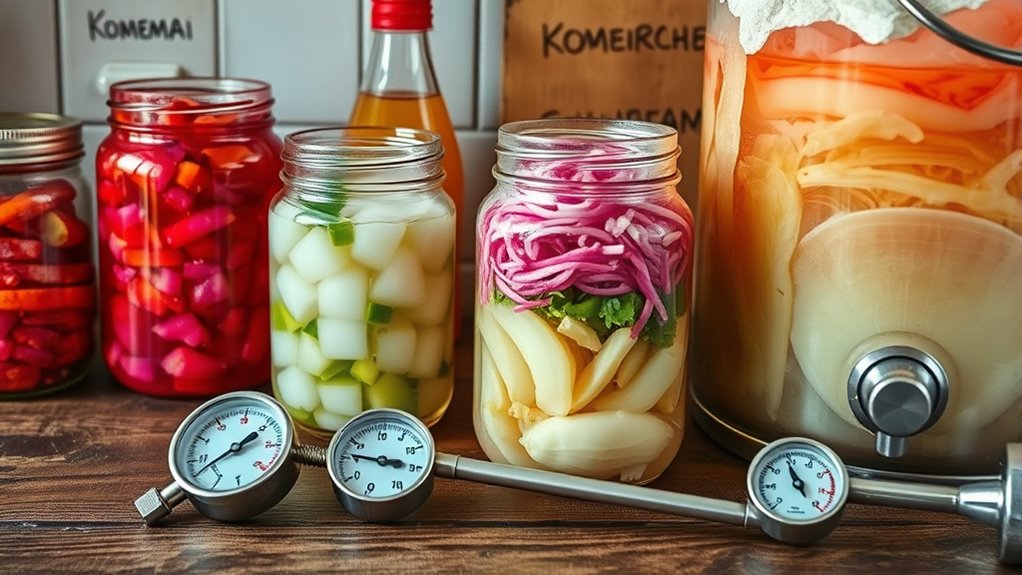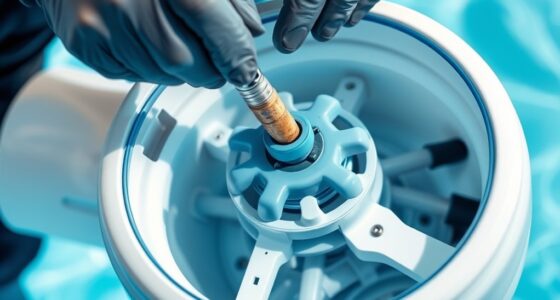To safely make fermented foods at home, use basic clean equipment like jars with airtight lids and fermentation weights. Understand that microorganisms convert sugars into acids or alcohol, which preserves foods and enhances flavors. Keep everything sanitized and follow proper salt and temperature guidelines—ideally between 65-75°F—to prevent harmful bacteria. Monitoring your ferment regularly and discarding spoiled batches helps ensure safety. By knowing the science behind it, you’re set to create delicious, safe ferments—learn more to perfect your skills.
Key Takeaways
- Use proper, clean fermentation equipment like jars, weights, and breathable covers to prevent contamination.
- Maintain the correct temperature (65-75°F) to promote safe and effective fermentation.
- Submerge ingredients fully in brine or starter cultures to minimize oxygen exposure and inhibit spoilage.
- Regularly monitor for spoilage signs such as off-odors or fuzzy growths, and discard unsafe batches.
- Understand the fermentation science to optimize flavor, safety, and process control at home.

Fermented foods are a simple and rewarding way to boost your health and add flavor to your meals. When you include fermented foods in your diet, you’re tapping into their probiotic benefits, which support your gut health, improve digestion, and strengthen your immune system. But to enjoy these benefits safely, understanding the science behind fermentation and using proper equipment is essential.
The first step is choosing the right fermentation equipment. You don’t need fancy gadgets—simple jars with airtight lids, fermentation weights, and breathable covers work well. These tools help create a controlled environment by allowing gases to escape while preventing unwanted bacteria or mold from contaminating your food. Proper equipment ensures your fermentation process remains safe and consistent, reducing the risk of spoilage or harmful bacteria growth.
Simple jars, weights, and breathable covers keep fermentation safe and consistent.
Next, it’s *imperative* to understand the science of fermentation. When you add salt, bacteria, and sometimes sugar to vegetables or dairy, naturally occurring microorganisms begin converting sugars into lactic acid or alcohol, creating the tangy flavors you love. This process not only enhances taste but also preserves the food naturally. *Guaranteeing* the right environment—clean equipment, proper salinity, and correct fermentation time—keeps out spoilage organisms and promotes the growth of beneficial probiotics. Additionally, HEPA filtration can be helpful in maintaining a clean environment by reducing airborne contaminants during fermentation.
Maintaining safety during fermentation involves paying close attention to cleanliness. Wash your hands and all equipment thoroughly before starting. Keep your ingredients submerged in brine or starter cultures to prevent oxygen exposure, which can lead to mold. Monitoring your ferment regularly helps you catch any signs of spoilage early, like off-odors or fuzzy growths, so you can discard questionable batches before they pose health risks.
Temperature plays a *key* role as well. Most fermentation occurs best between 65-75°F (18-24°C). Too warm, and unwanted bacteria could thrive; too cold, and fermentation may slow down or stop altogether. Using a fermentation chamber or a dedicated corner of your kitchen can help maintain consistent temperatures. If you’re new to fermenting, start with small batches to learn how your environment influences the process, and always label your jars with the date so you can track fermentation progress.
Frequently Asked Questions
How Long Does Homemade Fermentation Typically Take?
The fermentation timeline varies depending on the food and conditions, but typically, fermentation duration can range from a few days to several weeks. You should check your recipe for specific guidance, but generally, you’ll notice bubbling and a tangy smell as signs of progress. Keep in mind that fermentation duration depends on temperature, ingredients, and your taste preferences, so taste-test periodically to find your ideal flavor.
Can I Ferment Foods in Plastic Containers Safely?
You can ferment foods in plastic containers, but plastic container safety depends on the type of plastic you use. Choose fermentation container choices that are food-grade, BPA-free, and designed for fermentation. Some plastics may leach chemicals into your food over time, so it’s best to avoid reused or low-quality plastics. For safer and more durable options, consider glass or ceramic containers, but if you use plastic, verify it’s specifically made for fermentation purposes.
What’s the Ideal Temperature for Fermentation?
You ask about the ideal temperature for fermentation, and temperature control is key to managing microbial activity. Generally, keep your fermenting foods between 65-75°F (18-24°C). This range encourages beneficial microbes to thrive while preventing spoilage. Too warm, and bad bacteria may dominate; too cold, and fermentation slows. Monitoring and maintaining this temperature guarantees your fermentation process stays safe and successful, giving you flavorful, healthy results.
How Do I Prevent Mold Growth During Fermentation?
To prevent mold growth during fermentation, you should use effective mold prevention techniques like keeping your setup clean and ensuring the fermenting environment stays submerged and covered. Monitoring the fermentation mold risks regularly helps you spot issues early. Maintain proper temperature and avoid introducing contaminants. By practicing these mold prevention techniques, you reduce the chance of mold taking hold, ensuring your fermented foods stay safe and delicious.
Are There Any Signs of Harmful Bacteria in Fermented Foods?
Did you know that about 1 in 10 foodborne illnesses are caused by bacterial contamination? When checking your fermented foods, look for mold indicators like fuzzy spots or off-colors, which can signal harmful bacteria. If you spot any mold or strange smells, it’s safest to discard the batch. Trust your senses—visual cues and odors alert you to potential risks, helping you enjoy your fermented creations safely.
Conclusion
Now that you understand the safety and science behind fermenting foods at home, you’re ready to commence on this flavorful journey. Just like a skilled gardener tending to delicate plants, you’ll nurture your ferments with care and attention. Remember, patience and cleanliness are your best allies. With each batch, you’ll discover a world of taste and health benefits, turning your kitchen into a laboratory of delicious, probiotic-rich creations. Happy fermenting!









